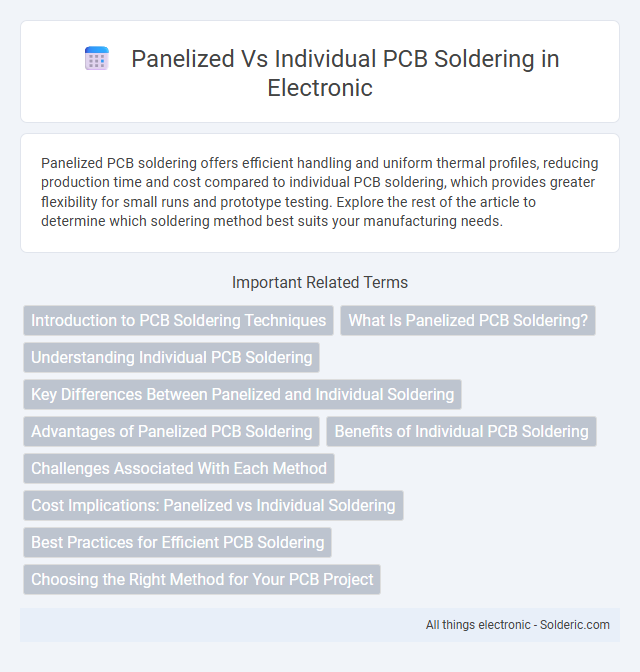Panelized PCB soldering offers efficient handling and uniform thermal profiles, reducing production time and cost compared to individual PCB soldering, which provides greater flexibility for small runs and prototype testing. Explore the rest of the article to determine which soldering method best suits your manufacturing needs.
Comparison Table
| Feature | Panelized PCB Soldering | Individual PCB Soldering |
|---|---|---|
| Process Speed | Faster due to batch handling | Slower, one board at a time |
| Cost Efficiency | Lower per unit cost | Higher per unit cost |
| Defect Handling | Defects affect entire panel | Isolated defect impact |
| Manufacturing Complexity | Requires panel tooling | Minimal tooling needed |
| Production Volume Suitability | Ideal for high volume | Best for low volume or prototypes |
| Material Waste | Less waste with optimized layouts | More waste due to individual setups |
| Assembly Accuracy | Consistent across all PCBs | Varies per board |
Introduction to PCB Soldering Techniques
Panelized PCB soldering offers enhanced efficiency by assembling multiple circuit boards simultaneously, reducing production time and cost compared to individual PCB soldering. Individual PCB soldering provides greater flexibility for customization and prototyping, allowing precise placement and rework of components on single boards. Your choice between these techniques depends on production volume, complexity, and specific project requirements for quality and turnaround.
What Is Panelized PCB Soldering?
Panelized PCB soldering involves assembling and soldering multiple printed circuit boards (PCBs) joined together in a single panel, improving manufacturing efficiency and reducing handling times. This method uses a larger array of connected PCBs, allowing simultaneous processing during soldering operations such as reflow or wave soldering. Your production line benefits from enhanced consistency and faster throughput compared to individual PCB soldering, where each board is handled separately.
Understanding Individual PCB Soldering
Individual PCB soldering involves attaching components directly onto a single printed circuit board, allowing for precise control over each solder joint. This method facilitates detailed inspection and rework, reducing the risk of defects in complex or prototype circuits. It is particularly advantageous for low-volume production runs where customization and flexibility are critical.
Key Differences Between Panelized and Individual Soldering
Panelized soldering involves assembling multiple PCBs simultaneously on a single panel, enhancing production efficiency and consistency, while individual soldering handles each PCB separately, allowing for more precise and customized work. You benefit from panelized soldering through reduced handling time and improved alignment during reflow processes, whereas individual soldering offers greater flexibility for prototypes or small batches. The key difference lies in throughput and scalability for panelized methods versus detailed, high-accuracy soldering for individual units.
Advantages of Panelized PCB Soldering
Panelized PCB soldering significantly enhances manufacturing efficiency by allowing multiple boards to be processed simultaneously, reducing handling time and minimizing production costs. This method improves assembly accuracy and consistency through automated alignment and solder paste application across all PCBs in the panel. Enhanced structural rigidity of panels also prevents board warping during soldering, leading to higher yield rates and improved overall product quality.
Benefits of Individual PCB Soldering
Individual PCB soldering offers enhanced precision and quality control by allowing focused inspection and rework on each board, reducing the risk of defects. You benefit from greater flexibility in handling varied board sizes and configurations without the constraints of panel dimensions. This method also minimizes material waste and improves turnaround time for small batch production or prototypes.
Challenges Associated With Each Method
Panelized PCB soldering presents challenges such as difficulty in managing heat distribution evenly across the entire panel, which can lead to solder joint inconsistencies and potential damage to sensitive components. Individual PCB soldering requires precise handling and alignment, increasing the risk of component misplacement or solder bridging due to the smaller working area and lack of structural support. Your choice must consider these trade-offs between efficiency in mass production and the meticulous control possible with individual board handling.
Cost Implications: Panelized vs Individual Soldering
Panelized PCB soldering significantly reduces manufacturing costs by enabling simultaneous processing of multiple boards, which lowers labor and machine setup expenses. Individual PCB soldering incurs higher costs due to increased handling time and setup changes for each board, leading to less efficient use of resources. Choosing panelized soldering improves throughput and cost-efficiency, especially in high-volume production runs.
Best Practices for Efficient PCB Soldering
Panelized PCB soldering improves efficiency by enabling simultaneous processing of multiple boards, reducing handling time and ensuring consistent heat distribution across components. Individual PCB soldering allows precise attention to each unit but requires more frequent setup adjustments and longer cycle times. Optimize your workflow by selecting panelized soldering for high-volume production and individual soldering for prototypes or small batches to balance speed and quality.
Choosing the Right Method for Your PCB Project
Selecting the right soldering method for your PCB project depends on factors like production volume, precision, and cost efficiency. Panelized PCB soldering offers higher throughput and uniformity for mass production by assembling multiple boards simultaneously, while individual PCB soldering provides greater flexibility and control for prototypes or small batches. To optimize your workflow and ensure quality, evaluate your project's scale and complexity before deciding between panelized and individual soldering techniques.
panelized vs individual PCB soldering Infographic

 solderic.com
solderic.com